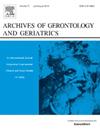The effectiveness of cognitive behavioral therapy on loneliness among older adults: A systematic review and meta-analysis
IF 3.8
3区 医学
Q2 GERIATRICS & GERONTOLOGY
引用次数: 0
Abstract
Objective
To evaluate the efficacy of Cognitive Behavioral Therapy (CBT) on improving loneliness among older adults.
Design
A systematic review and meta-analysis.
Methods
A systematic search was conducted across 10 electronic databases from their inception to June 21, 2025, to identify eligible randomized controlled trials (RCTs). Studies included older adult participants aged 60 years or above. Two reviewers independently performed the screening process, data extraction, and quality assessment of the selected studies. All statistical analyses were carried out using Stata version 18.0.
Results
Eight RCTs involving 720 participants were included. Pooled analysis revealed a significant and large effect of CBT on improving loneliness among older adults (SMD = -1.00, 95 % CI, -1.59 to -0.42, p < 0.001; low-quality evidence), though substantial heterogeneity was present (I² = 90.5 %). Subgroup analyses indicated that shorter intervention duration (≤12 weeks) (SMD = -1.41, 95 % CI: -2.51 to -0.32, p = 0.011), group-based format (SMD = -1.49, 95 % CI: -2.63 to -0.36, p = 0.010), and online delivery (SMD = -1.51, 95 % CI: -3.93 to 0.92, p = 0.233) may enhance intervention effectiveness. Subgroup analyses also revealed differences across settings. CBT interventions were effective among community-dwelling older adults (SMD = -0.91, 95 % CI: -1.46 to -0.35, p = 0.001), whereas no significant effect was observed among institution-dwelling populations.
Conclusion
CBT was associated with improvements on loneliness among older adults. However, given the substantial heterogeneity observed across studies, these pooled estimates should be interpreted as exploratory rather than definitive. Subgroup findings suggest that intervention format, intervention duration, delivery modality and settings may influence outcomes. Further well-designed rcts are needed to confirm the effectiveness.
认知行为疗法对老年人孤独感的有效性:系统回顾和荟萃分析。
目的:评价认知行为疗法(CBT)改善老年人孤独感的效果。设计:系统回顾和荟萃分析。方法:系统检索10个电子数据库,从其建立到2025年6月21日,以确定符合条件的随机对照试验(rct)。研究对象为60岁或以上的老年人。两名审稿人独立进行筛选过程、数据提取和所选研究的质量评估。所有统计分析使用Stata 18.0版本进行。结果:纳入8项随机对照试验,共720名受试者。合并分析显示,CBT对改善老年人孤独感有显著而巨大的影响(SMD = -1.00, 95% CI, -1.59至-0.42,p < 0.001;低质量证据),尽管存在大量异质性(I²= 90.5%)。亚组分析表明,较短的干预时间(≤12周)(SMD = -1.41, 95% CI: -2.51至-0.32,p = 0.011)、基于组的形式(SMD = -1.49, 95% CI: -2.63至-0.36,p = 0.010)和在线交付(SMD = -1.51, 95% CI: -3.93至0.92,p = 0.233)可提高干预效果。亚组分析也揭示了不同设置之间的差异。CBT干预在社区居住的老年人中是有效的(SMD = -0.91, 95% CI: -1.46至-0.35,p = 0.001),而在机构居住人群中没有观察到显著的效果。结论:CBT与老年人孤独感的改善有关。然而,考虑到研究中观察到的大量异质性,这些汇总估计应该被解释为探索性的,而不是决定性的。亚组研究结果表明,干预形式、干预持续时间、交付方式和环境可能会影响结果。需要进一步精心设计的随机对照试验来证实其有效性。
本文章由计算机程序翻译,如有差异,请以英文原文为准。
求助全文
约1分钟内获得全文
求助全文
来源期刊
CiteScore
7.30
自引率
5.00%
发文量
198
审稿时长
16 days
期刊介绍:
Archives of Gerontology and Geriatrics provides a medium for the publication of papers from the fields of experimental gerontology and clinical and social geriatrics. The principal aim of the journal is to facilitate the exchange of information between specialists in these three fields of gerontological research. Experimental papers dealing with the basic mechanisms of aging at molecular, cellular, tissue or organ levels will be published.
Clinical papers will be accepted if they provide sufficiently new information or are of fundamental importance for the knowledge of human aging. Purely descriptive clinical papers will be accepted only if the results permit further interpretation. Papers dealing with anti-aging pharmacological preparations in humans are welcome. Papers on the social aspects of geriatrics will be accepted if they are of general interest regarding the epidemiology of aging and the efficiency and working methods of the social organizations for the health care of the elderly.

 求助内容:
求助内容: 应助结果提醒方式:
应助结果提醒方式:


